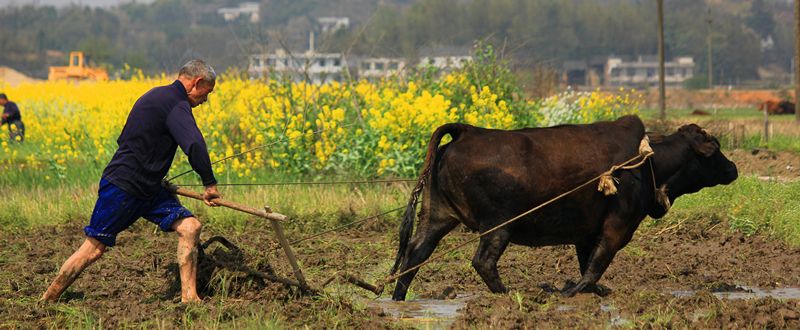Hakka Gongfu: Iron Ox Cultivates Land (鉄牛耕地)By Shifu Adrian Chan-Wyles (PhD)
For hundreds of years, and probably longer, the ‘ox’ has been an important and central aspect of rural Hakka farming life. A good and strong ox was far more valuable as a ‘living’ agricultural machine, than as food, and would generally be very well looked after into old age. The Hakka men and women who guided the plough and the ox through the fields, had to innately understand the nature of the ox, and the strength and weaknesses it exhibited. This included learning how to hold and guide the plough, and develop from a young age, the strength and agility to perform this task correctly. Many Hakka farmers went bare-foot to grip the earth in a more efficient manner, often wearing trousers cut-off at the knee (exposing the lower legs). Moving with the plough as it broke-through, cut-up and turned the earth, required a good sense of balance, and ability to keep moving in a fluid manner, and to suddenly stop and start as required. The legs had to be strong, solid and yet supple and able to change direction and rhythm. The lower-back and pelvic-girdle had to be strong and supple, and able to move in all directions without causing injury to the spine or joints. This suppleness and strength had to also spread through the middle and upper spine, be present throughout the shoulder-girdle, and suitably expressed through the neck, arms and hands. When all this was accomplished, the head sat squarely upon the shoulders, tilting and moving as required to retain balance and direction. The hands had to develop an iron-like grip that both held the plough strongly, whilst being supple enough to guide and steer as required. Over-all, the mind and body of the Hakka farmer had to be as one with the ox and land being cultivated. Ploughing a field using an ox, required the Hakka farmer to be incredibly fit and strong, as well as intelligent, calm, and attentive to the job at hand. Furthermore, the Hakka farmer developed a respect for nature and for the animal that faced all the hard-labour.
This ox-inspired ability and strength of the Hakka farmer formed the basis of the mind and body conditioning of Hakka martial arts (of which there are many). When working on the fields, there was no need to carry-out extra body-conditioning training for martial arts practice – as the fitness and strength was already present and maintained through the agricultural life-style. However, as Hakka people migrated into areas where hard physical farming was replaced with other means of livelihood, the fitness and strength gained in the fields was codified into a set of martial-related exercises that logically conditioned the entire body from head to toe. This is how the qigong exercises known as ‘Iron Ox Cultivates the Land’ (Tie Niu Geng Di) came to be ‘separate’ from Hakka farming, and formed a distinct martial training regimen. Within the Hakka Ch’an Dao (禅道) System (also known as ‘Chan Gar’ [陳家]), this technique is more commonly referred to as ‘Iron Vest’ (鐵衫 – Tie Shan) training, which develops a tough and deflecting exterior (surrounding and protecting a relaxed and healthy interior). Just as the ox ‘touches’ the ground, so does the Hakka martial artist whilst performing various press-ups, sit-ups, back-raises and squat-kicks, etc. These movements build bone-density, as well as muscle strength, together with strong but flexible ligaments and tendons. Just as these various exercises ‘strengthen’, so do they ‘loosen’ the body. The press-up, for example, signifies the ox placing its head low to summon the strength to pull the plough through the hard ground. The ox uses the stomach muscles to contract and relax as the plough moves, gets stuck, and is freed again. As the legs sink into the earth, the ox bends the knee and extracts the limb – this is the squat-kick, and as the broad back carries the plough and the farmer – this is the back-raise of the gongfu practitioner. Finally, for many Hakka gongfu practitioners, standing in ‘Horse Stance’ (馬步 – Ma Bu) is actually holding the ‘Ox Stance’ (牛步 – Niu Bu). ©opyright: Adrian Chan-Wyles (ShiDaDao) 2017. |
